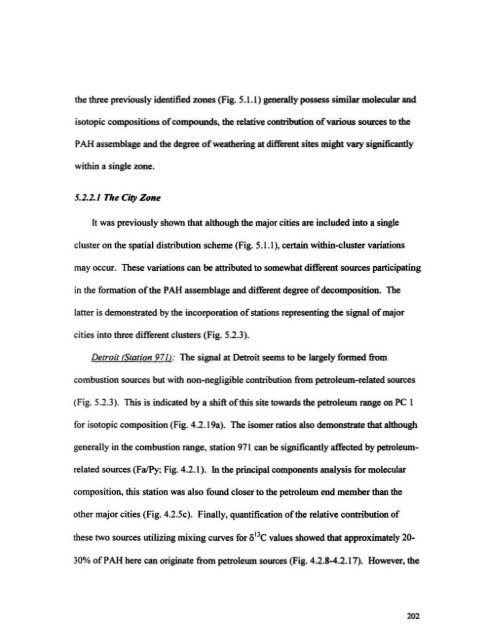I'r - Memorial University of Newfoundland
I'r - Memorial University of Newfoundland
I'r - Memorial University of Newfoundland
Create successful ePaper yourself
Turn your PDF publications into a flip-book with our unique Google optimized e-Paper software.
the three previous ly identified zones (Fig. 5.1.1) generally possess similar molecular and<br />
isotopic compositions <strong>of</strong>compounds. the relative coorribulioo <strong>of</strong>various soum:s 10 the<br />
PAH assemblage and the degree <strong>of</strong>weatbering at differcnr: sites might vary significantly<br />
within a single zooc.<br />
5.1.2.1 The City Zorre<br />
It was previously shown that although the major cities arc included into a single<br />
cluster on the spatial distribution scheme (Fig. 5.1.1), certain within-cluster variations<br />
may occur. These variations can be attributed to somewhat different sources participating<br />
in the formation <strong>of</strong>thc PAH assemblage and diffcrcnt degree<strong>of</strong>decompositioD. The<br />
tarter is demonstrated by the incorporation <strong>of</strong>stations representing the signal <strong>of</strong>major<br />
cities into three different clusters (Fig. 5.23).<br />
{)etroit (StQtion 970: Thesignal at Detroit seems10 be largely formed from<br />
combustion sources but with non-negligible cootribution from pctroIeum-rdatcd sources<br />
(Fig. 5.2.3). This is indicated by a shift <strong>of</strong> this site towards the petroleum range 00 PC I<br />
for isotopic composition (Fig. 4.2.19a). The isomer natios also demonstrate that although<br />
generally in the combustion range , station 971 can be significantly affected by pctrolewn<br />
related sources (FaIPy; Fig. 4.2.1). In the principal components analysis for molecular<br />
composition. this station was also found closer to the petroleum end member than the<br />
other major cities (Fig. 4.2.5c). Finally, quantification <strong>of</strong>thc relative contribution <strong>of</strong><br />
these two sources utilizing mixin g curves for oDe values showed that app roximately 20<br />
30C'/o <strong>of</strong> PAH here can originate from petroleum sources (Fig. 4.2.8-4.2.17). However. the<br />
202

















